The Skyrian horse
Many contradicting points of view have been expressed on the origins of the Skyrian horse and its historical course in Skyros. During the last century the Principle of the Veterinary Clinic of Athens of that time Petros Constantinides writes “…. Because of the fact that the horses curved in the ancient monuments don’t bear any resemblance to the
Skyrian horses, along with the fact that none of the ancient writers has described or made reference to such small-bodied horses, some assume that they were unknown during the ancient times and that they are “dwarf” horses of the northern type originating from the northern countries of Asia and Europe, that they were brought to the Aegean islands by trade during the Roman times. Due to the isolation of Skyros and the lack of communication, these”dwarf” horses remained pure and kept their initial type.

Others accept the fact that during much older times there was a kind of small horse in Attica that had the height of a goat, bearing three ungulae that was called hipparion. This species as it was confirmed by the excavations in Pikermi was completely extinct and there is a belief that the Skyrian horses are the last representatives of that species. We are of the opinion that neither sculptural art nor the ancient writers would spend time in horses that could be used neither in war operations nor in horse-racing and harness draught.
We cannot accept the argument that Skyros was in such isolation as to consider impossible the transfer of stud mares and stud horses of other species in order to evolve the Skyrian horse. But the other point doesn’t seem possible either since an evolution that improves and increases the body but reduces the number of ungulae cannot be easily believable.
It is certain that many through the ages have tried to genetically improve the Skyrian horse by importing stud horses and stud mares of Semitic type from various places and in particular from the East but despite the persistent thoroughness and care after the second or third generation the horses became half breed and after the fourth generation they became like the native horses in respect to their size and all the other features.
Furthermore, taking into consideration the small body size of the native oxen, donkeys, hares, and partridges, we are led to the conclusion that this land and this environment conditions of the nutrition of the animals is the reason that keeps them always small-bodied.

Many years later the professor Th. Anticas writes on the same subject : ” ..the Skyrian horse is one of the most ancient and rare small-bodied horse races in the world. It is not mentioned in any ancient scripts but it is likely that it comes from Thessaly or Pindos and it passed to Sporades islands in the 18th-19th century or much earlier.
In the age of bronze the cavalry of Achilles passed through Skyros on its way to Troja. The small size of the Skyrian horse is due to the frugal diet, the adverse environmental conditions and the relative scarse breeding that in fact created its genotype and phenotype.
Genetic analysis and research in the Laboratory of Physiology Breeding of Farm Animals of the Aristotle University of Thessaloniki has shown that the race of Skyros horses is the most homogeneous race in Greece.
It is also possible that this small-bodied horse used to live in other places too during the ancient times since the body measuring studies of the horse figures showed that during the Classical period there were already horses of approximately the same height”
https://www.nationalgeographic.com/animals/article/skyros-ponies-horses-rare-breed


